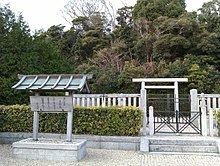Reign 758–764 Mother Tagima no Yamashiro Successor Empress Koken Parents Prince Toneri | Spouse Awata no Morone Role Prince Predecessor Koken Name Emperor Junnin | |
 | ||
Burial Awaji no misasagi (Hyogo) Grandparents Emperor Tenmu, Princess Niitabe Similar People Emperor Tenmu, Emperor Jimmu, Kakuei Tanaka, Akihito, Hirohito | ||
Emperor Junnin (淳仁天皇, Junnin-tennō, 733 – November 10, 765) was the 47th emperor of Japan, according to the traditional order of succession. The seventh son of Prince Toneri and a grandson of Emperor Tenmu, his reign spanned the years 758 to 764.
Contents
Traditional narrative
Before his ascension to the throne, his name (imina) was Ōi-shinnō (Ōi-no-ō). He was the seventh son of Prince Toneri, a son of Emperor Tenmu. And although his father died when he was three, he was not given any rank or office at the court. In the older Japanese documents, he is usually referred to as Haitei (廃帝), the unthroned emperor. The posthumous name of Emperor Junnin was given by Emperor Meiji a thousand years later.
Ascension and reign
In 757 the Empress Kōken, his third cousin appointed him to be her crown prince instead of Prince Funado, who had been appointed to this position in the will of the Emperor Shōmu. In the tenth year of Kōken-tennō 's reign (称徳天皇十年), on December 7, 758 (Tenpyō-shōhō 2, 1st day of the 8th month), the empress abdicated and the succession (senso) passed to her adopted son. Shortly afterwards, Emperor Jimmu is said to have ascended to the throne (sokui). In 760 (Tenpyō-hōji 4), additional coins were put into circulation—copper coins bearing the words Mannen Ten-hō, silver coins bearing the words Teihei Genhō, and gold coins bearing the words Kaiki Shōhō.
The years of Junnin's reign, 758–765, are more specifically encompassed within a single era name or nengō.Tenpyō-hōji Junnin seemingly had very little power and was a mere figurehead. [Upclosed.come]|date=March 2013}} In 764, six years after Empress Kōken had stepped down, the former empress reclaimed the throne during the Fujiwara no Nakamaro Rebellion, forcing Junnin to abdicate.
Death and mausoleum
On November 10, 765 (Tenpyō-jingo 1, 23rd day of the 10th month), the former emperor died while in exile. The site of Junnin's actual grave is unknown, and he is traditionally venerated at a memorial Shinto shrine (misasagi) at Awaji. The Imperial Household Agency designates this location as Junnin's mausoleum: It is formally named Awaji no misasagi.
Though Junnin had, technically, been emperor, he was not featured on the official List of Japanese Emperors until the late nineteenth century. In 1870, Emperor Meiji conferred the posthumous name and title by which Emperor Junnin is now known. His place in the traditional order of succession was confirmed at the same time as announcements about Emperor Kōbun and Emperor Chūkyō were made public.
Kugyō
Kugyō (公卿) is a collective term for the few most powerful men attached to the court of the Emperor of Japan in pre-Meiji eras. In general, this elite group included only three or four men at a time, and they were hereditary courtiers whose experience and background would have brought them to the pinnacle of their careers. During Junnin's reign, this group of Daijō-kan included:
